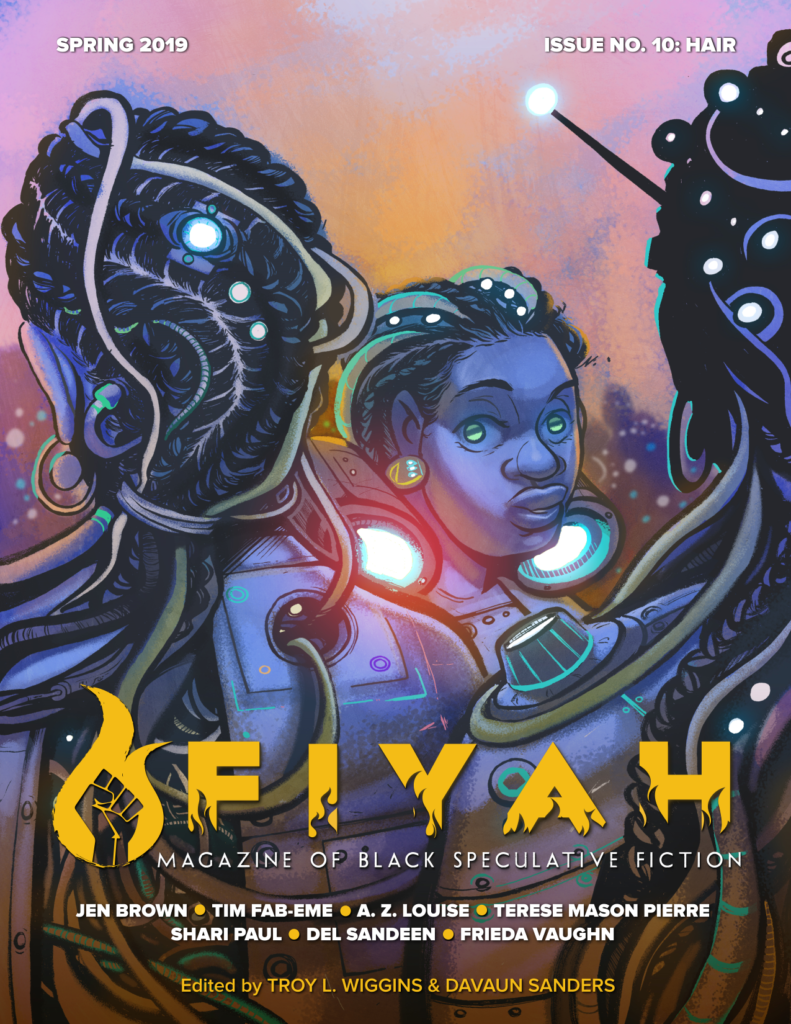Short Fiction Review: April 2019

My favorite stories often revolve around similar themes: justice, community, gender, and religion. In April 2019, the dominant themes in my favorite stories were gender and justice (or lack thereof), two important topics that intersect our lives in countless ways. These stories include “In That Place She Grows a Garden” by Del Sandeen in FIYAH Literary Magazine; “A Conch-Shell’s Notes” by Shweta Adhyam in Lightspeed Magazine; and “Vīs Dēlendī” by Marie Brennan in Uncanny Magazine. I found these stories emotionally and intellectually engaging, and they asked me to approach the themes of gender and justice from a variety of perspectives.
Short Fiction Review: March 2019

This past month, my three favorite stories all happened to be love stories. None of these stories are exactly typical or traditional love stories, which I think is the reason I liked them so much. “Green Glass: A Love Story” by E. Lily Yu feels like a fun romcom about the super-wealthy. It’s also a sharp critique of the 1%. It appears in If This Goes On, a new anthology edited by Cat Rambo. “Every Song Must End” by Bonnie Jo Stufflebeam, which appears in Uncanny Magazine, is a moving, intelligent meditation on love, which centers around two polyamorous couples. “Octonet” by Keyan Bowes appears in Escape Pod and was part of Artemis Rising 5, an annual event put on by the Escape Artists podcast network featuring authors of marginalized genders and sexes. Although “Octonet” does include a lovely romance between two women, it’s mostly a love story about octopuses. If you agree octopuses are awesome, you’ve got to read this. If you haven’t yet realized how awesome octopuses are, you should also check this out.
Short Fiction Review: February 2019

February saw the release of A People’s Future of the United States, an anthology of resistance and hope that’s edited by Victor LaValle and John Joseph Adams and features big names such as Charlie Jane Anders, Hugh Howey, N. K. Jemisin, Sam J. Miller, and Catherynne M. Valente. The anthology is filled with great work, and in particular I want to spotlight “Riverbed” by Omar El Akkad and “Harmony” by Seanan McGuire. I could easily rave about A People’s Future of the United States for the rest of this review, but I also want to spotlight some other great new stories by less well-known authors. In February, Nightmare Magazine published “58 Rules to Ensure Your Husband Loves You Forever” by Rafeeat Aliyu, a creative and disturbing take on zombies that powerfully comments on toxic social norms around marriage. This piece is dark and disturbing, so it won’t be for everyone, but if you like horror, I highly recommend it. I also enjoyed “This Wine-Dark Feeling That Isn’t The Blues” by José Pablo Iriarte, which appears in Escape Pod. It’s a short and surprising story about love, grief, and simulated realities. Lastly, I loved “Ti-Jean’s Last Adventure, as Told to Raccoon” by KT Bryski, which appears in Lightspeed Magazine. It’s a very Canadian story that’s equal parts fun folklore and serious cultural critique.
Short Fiction Review: December 2018 – January 2019

One of my favorite stories I’ve read recently is “The Thing About Ghost Stories” by Naomi Kritzer, which appears in Uncanny Magazine. It’s a ghost story about a folklorist who studies ghost stories. If you like ghost stories, classification systems, mother/daughter relationships, or academic scholarship, this is a story for you. “2086” by T.K. Lê, which appeared in Strange Horizons, is another ghost story of sorts. It’s an accessible yet difficult story about immigration, family, and who’s actually valued and wanted within society. I also loved “On the Origin of Specie” by Vajra Chandrasekera, which appears in Nightmare Magazine. It’s a dark, compelling, and claustrophobic examination of taxation, protest, and agency. Lastly, for an intriguing story that blends science fiction with mythology, I recommend you check out “One’s Burden, Again” by Natalia Theodoridou, which appears in Clarkesworld Magazine.
Month of Joy: Gender Diverse Pronouns by Cameron Coulter

Gender diverse pronouns bring me joy. What are gender diverse pronouns? In short, they’re all the alternatives to she and he (for people—I’m not counting “it”). In the introduction to Capricious Issue 9: Gender Diverse Pronouns, editor A.C. Buchanan writes that gender diverse pronouns include “singular they, neopronouns, and pronoun sets of the authors’ invention.” What’s a neopronoun? Often, people use the term neopronoun to refer to gender neutral pronouns that can be used instead of singular they. I’m borrowing A.C. Buchanan’s term for this post because it’s broad, encompassing singular they, other gender neutral pronouns, and even pronouns which signify a gender identity beyond femininity or masculinity. All of these things—all of these gender diverse pronouns—bring me great joy. I love singular they pronouns. I love gender neutral neopronouns. I love invented pronouns which signify nonbinary genders. I love stories that feature characters—and societies—that use gender diverse pronouns, whether it’s singular they or entirely new pronouns that signify entirely new genders. These stories normalize diverse pronouns and gender identities, which is good and necessary work because people with diverse pronouns and gender identities are all around us.
Short Fiction Review: November 2018

This month we have three new stories by new (and newish) writers that all feature queer characters and interesting points of view. Let’s get right into it. First, if you like fairy tale retellings, check out “Toothsome Things” by Chimedum Ohaegbu, which appears in Strange Horizons. It’s an imaginative reworking of Little Red Riding Hood that’s poetic and powerful. Next, I loved “How to Swallow the Moon” by Isabel Yap, which appears in Uncanny Magazine Issue 25. This lovely novelette features a moving romance, a rad monster, and wonderful Filipino-inspired worldbuilding. Lastly, I recommend “Talk to Your Children about Two-Tongued Jeremy” by Theodore McCombs, which appears in Lightspeed Magazine Issue 102. It’s a smart and gripping story about how technology, society, and capitalism can sometimes mix together in tragic ways.

